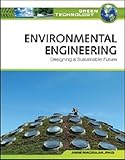Environmental engineering :
by Maczulak, Anne E.
Series: Green technology Published by : Facts On File, (New York :) Physical details: xv, 213 p. : ill. (chiefly col.) ; 25 cm. ISBN:9780816072002 (alk. paper); 0816072000 (alk. paper). Year: 2010 List(s) this item appears in: Energy C1 : C7 | GREEN BOOKS| Item type | Current location | Call number | Status | Date due | Barcode |
|---|---|---|---|---|---|
 Books
Books
|
Heliopolis University General Stacks | 628 MaE NB | Available | 002023 | |
 Books
Books
|
Heliopolis University General Stacks | 628 MaE | Available | 002024 |
Includes bibliographical references (p. 194-203) and index.
Preface -- Acknowledgments -- Introduction -- 1: New Directions In Civil Engineering -- History of environmental engineering -- Balancing resources and wastes -- Ecological design -- Case study: How do prairie dog tunnels work? -- Zero energy architecture -- Biomimicry -- Techniques used in engineering and design -- Abalone shell-designed for strength -- Conclusion -- 2: Designing Transit Systems -- Transport: Current status and future needs -- Urban transportation systems -- Personal vehicles -- Fuel efficiency -- Pedestrians and parking -- Commuter rails and buses -- Can bicycles make a difference? -- Air travel -- Roads -- Freight transport -- Case study: World's growing car culture -- Clean ships -- Alternatives to travel -- Conclusion -- 3: Innovations In Personal Vehicles -- New vehicles emerge -- Drag and energy loss -- Automobile industry -- Efficient vehicle design -- Aerodynamics -- Power -- Vehicle surface technology -- Case study: US interstate highways' effects on the environment -- Conclusion -- 4: Sustainable Manufacturing -- Today's manufacturing plants -- Wastes and emissions -- Heat energy -- Pollution control in manufacturing -- Zero discharge manufacturing -- Case study: Energy cost of making a car -- Sustainability and business -- Conclusion -- 5: Energy-Efficient Electronics -- Energy efficiency through the years -- Solar homes -- Smart appliances -- Lighting -- Case study: Learning from electric eels -- Home energy and heat storage -- Light -- Sensors and feedback -- Btu and the kilowatt -- Energy from nanotechnology -- Conclusion -- 6: Ecological Landscape Design -- Traditional landscape design -- Landscaping with nature -- Frank Lloyd Wright -- Ecological architecture -- Plants and trees -- Soil, water, and lawns -- Biodiversity gardens -- Rainwater harvesting -- Micro climates -- Walkways and driveways -- Case study: America's scenic byways -- Landscape design skills -- Conclusion -- 7: Sustainable Wastewater Treatment -- Energy-water connection -- Wastewater in developing countries -- Case study: Kufunda learning village, Zimbabwe -- Anaerobic digesters -- Gray water reuse -- Methane-cow power -- Ecological wastewater treatment -- Carbon adsorption -- Energy from wastewater -- Conclusion -- 8: Future Needs -- Appendixes -- Glossary -- Further resources -- Index.
From the Publisher: Green Technology is an eight-volume set that examines the relationship between human activities and their sometimes harmful consequences for the environment and explores new methods of repairing and restoring the Earth. Approaching environmental issues confronting society from a technological perspective has spawned significant controversy, and the books in this set present all sides of the debate. Designed to complement science curricula, the set also covers relevant history and new green technologies and innovations that will contribute to the field in the future. Environmental Engineering: Designing a Sustainable Future examines how this field, which incorporates not only aspects of art and design but also physics, geology, ecology, and the chemistry of matter, evolved from a discipline of civil engineering. Environmental engineers learn how to work with nature to improve and control the quality of the land, air, and water for the benefit of human and nonhuman cohabitation. Sidebars, figures, and case studies enhance fundamental concepts and examine urgent issues related to the "natural future" of the environment. The volume includes information on: aerodynamics; ecological and energy "architecture"; energy-efficient electronics; innovations in personal vehicles; landscape design; micro climates; solar homes; sustainable manufacturing; transit systems; and wastewater. The book contains 50 color photographs and line illustrations, five appendixes, a glossary, a detailed list of print and Internet resources, and an index. Green Technology is essential for high school students, teachers, and general readers who seek information on the important issues that affect the environment worldwide.

There are no comments for this item.